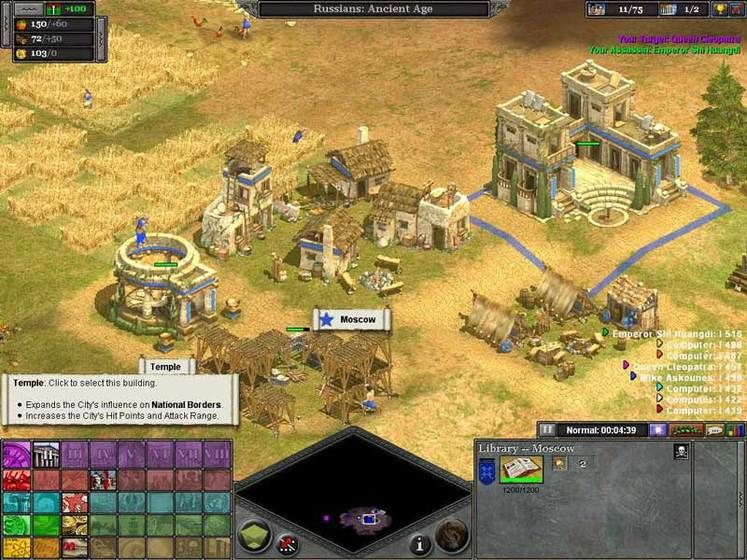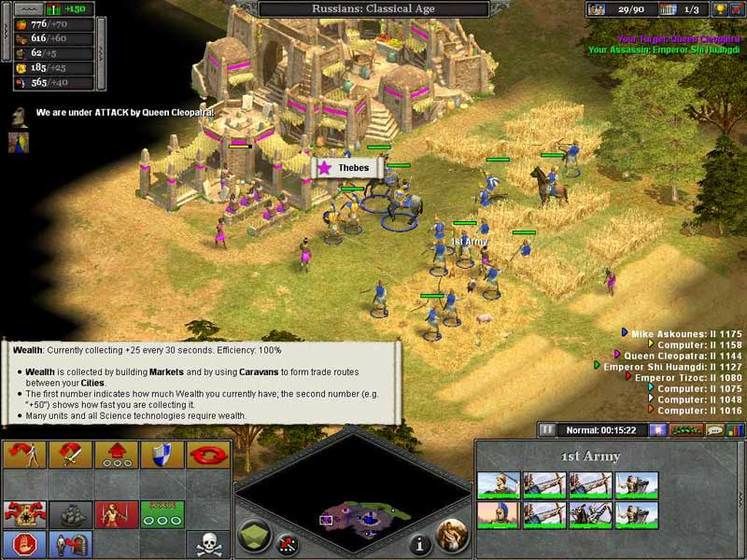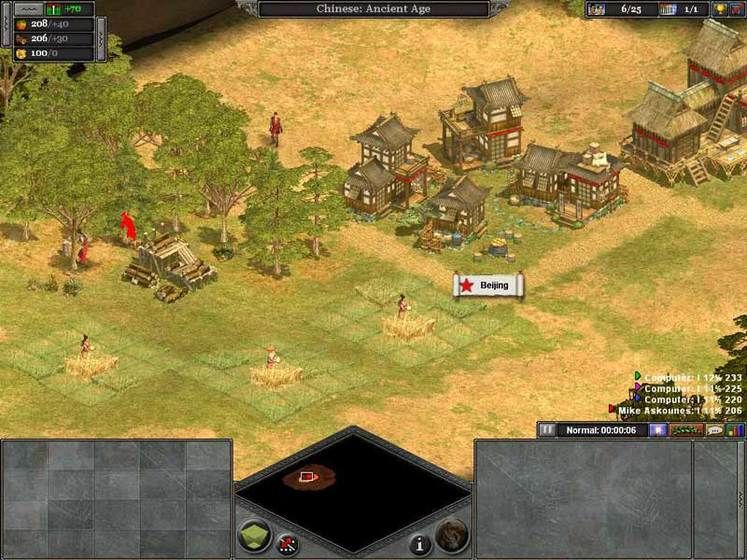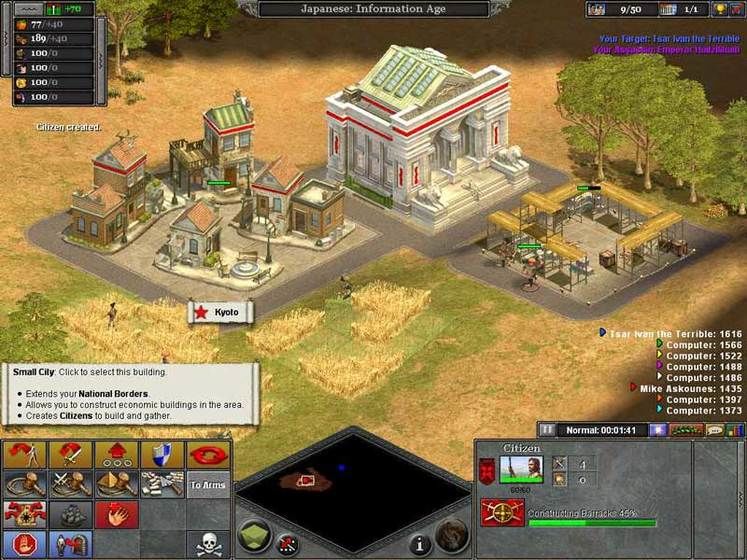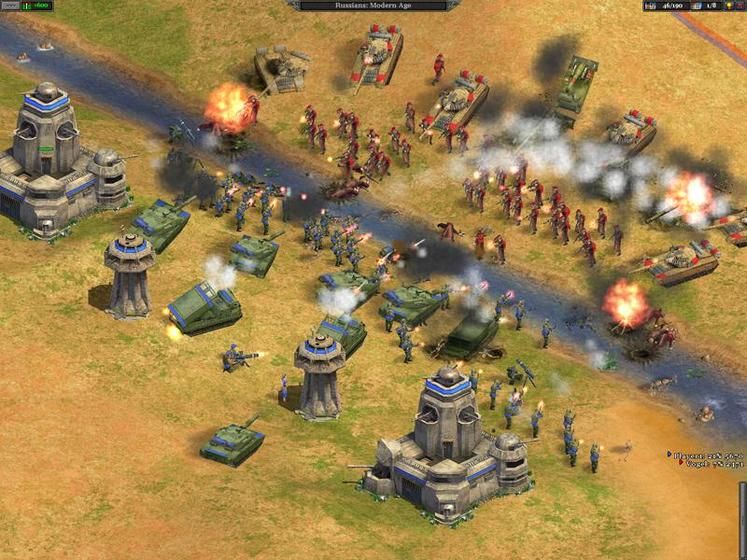Have you been wondering what all the fuss regarding the upcoming Rise of Nations (a collaboration between Big Huge Games & Microsoft) is about?
Having just received the Beta2 copy, I can happily say that I am in a position to put you in the picture. In a nutshell, imagine combining Civilization with Age of Empires, as well as throwing in a smattering of Risk or Total War and you get a game that looks, sounds and IS very impressive.
The intro graphics set the scene superbly - much akin to Age of Mythology - animation that is damn near to live film quality. This takes you nicely to the menu screen, which is where the fun really starts.
There is a multi stage Tutorial, allowing gamers of differing experience to jump in and catch up with any new innovations without having to ‘start from scratch’. Broadly speaking, the controls are of the standard variety meaning if you have played AoE or just about any other strategy game, you will soon have your units running around following your commands. Differences soon start appearing though - expansion is based upon the ‘city’ concept rather than the time honored ‘town hall’. Each City can only have a certain amount of buildings (5 farms for example) and, as more buildings are added, so the city size & strength grows with it. Buildings however can only be built within the city limits, so, to expand & conquer, you need to build new cities to expand your own borders. Resources gathered need to be within the city limits (shown as a red circle) and enhancements to buildings (i.e. a granary) will only affect production within that city. Resources themselves are ‘unlimited’ - assigning your citizens (not peasants) to get some lumber will not result in the eradication of the forest - you can assume a full programme of harvesting & replanting takes place ‘invisibly’. Once you have built your lumber mill, only a certain amount of citizens can work there, any spare will automatically find themselves something else to do within the city limits - if you have some ‘idle’ citizens, you can just send them to other cities to make up any shortfall.
The first city built is always your capital - it is automatically named Civ style, dependant on which of 18 differing nations you have chosen, although you have the option to rename it and any other cities to those of your choice. Your capital is vital, if it gets conquered, your game is over (more about that later). As you build more cities, you set up trade routes between them to garner yourself some gold and very soon roads will spring up as the caravans ply their trade. Various buildings within each city also directly affect the size of your territory through research and advancements. Temples are used to increase your influence (enlarge your borders) as well as maintain tax levels & thus your gold income.
There are 8 ‘Ages’ within the game enabling individual enhancements to your growing civilization, and these are reached through the research process. Your Library is the key to all research, clicking on it (or using the “L” hotkey) brings up tour research table unobtrusively in the bottom left of your screen. Here you can choose which of the 4 research paths (Military, Commercial, Civic or Science) is needed to bring about any changes you particularly desire. As your research develops, so you advance through the ages, hopefully gaining technological advantages over you competitors. Each advance costs though, so is inextricably linked to your resource production. This means it is vital to get a good economy going so as to be able to afford the changes you want to bring in.
There are 6 Resources; Gold, Food, Wood, Metal, Oil & Knowledge. The 1st 5 are acquired through the ‘normal routes (although Oil is not available until the Industrial age). Knowledge however, requires the construction of Libraries within your cities. Each Library can hold up to 7 scholars who beaver away at their books to produce the Knowledge so vital to successful development. In addition, each Library (like other major buildings) also has its own research paths that enable the scholars to improve their studies and increase the flow of Knowledge. While economic micromanagement is kept, to a large extent, ‘in the background’, Research is manually controlled & needs to be addressed regularly, both for the ‘main’ research as well as individual types. This is however, not an onerous task as the interface makes it quick & simple. You don’t need to look at a huge, complicated research tree to make your decisions, a swift tap of the “L” key & a quick glance around is all that is normally needed to make your decisions.
Also available for building are the good old Civilization ‘Wonders’ that can bestow advantages to your chosen race. As an example, once built, the Terracota Army generates an infantry squad on a regular basis, allowing you a pool of ready, but probably forgotten about, military might to further decimate your opponent.
Your military units all develop over time, from a basic slingshot unit through to “Special Services” types, with the addition of ‘extras’, like the Flamethrower, as your civilization develops. A nice enhancement here is that 1 infantry type unit is made up of 3 individuals, and, as they deploy, take full account of standard military tactics like flanking. Throwing a large force at an enemy results in some subtle strategical maneuvers rather than the standard head to head melee so typical of most strategy games. Barracks, Stables, Siege Factories and later, Airfields all need to be built as strategically as possible to ensure a flow of troops for defense and, of course, the all important offence. Battles tend to concentrate round cities and often follow the format of: attack a city - repel the inevitable counter attack, continue the attack until the city is about to fall, occupy the city with infantry, and, after 2 minutes, claim the city as your own & expand your borders accordingly. During the 2-minute “assimilation” phase, you need to ensure military superiority within the city limits, if a larger enemy force enters, the city will revert back to its former owner. It is here that the importance of the Capital city comes into play, Once the enemy’s capital is taken, it is ‘game over’ for him (or you if you are unfortunate enough to be on the receiving end). If you can locate the capital & take it, any remaining ‘enemy’ cities automatically come under your control and your borders expand dramatically. Good use can be made of air units to wear down city defenses (even to the extent of using cruise and/or nuclear missiles) so as to minimize losses and keep the all-important superiority. In addition, building a fortress allows you to utilize generals & spies, the former being able to make all the difference in any given situation as he directly affects the morale and capabilities of any army ‘under his control’, whilst the Spy can be used to subvert enemy units & acquire valuable knowledge of any enemy buildings and/or units.
So there you have it, a fantastic game that fully enhances any other RTS game out there &, to a degree, makes them obsolete. But, I hear you cry, what about the Risk/Total war elements - I saved the best for last.
Imagine all I described above as ‘just a skirmish’ game and you can see just how involved & hugely playable it is. Now, throw in a world map, choose one of 18 civilizations and go for world domination. I chose English and was presented with a breakdown of my chosen civilization showing all the advantages, disadvantages & special units etc. You then move onto the world map which shows all you control (just England at this stage) and all the countries you can invade, as well as strengths of ground troops, resource availabilities, bonuses etc. Being a chicken, I opted for Scandinavia as there was no formal army there - this lead to a “build & survive” scenario using all the elements described above (i.e. a ‘full’ game). In this instance, survive for 15 minutes. Starting with a basic city, I had to build barracks, troops & defenses as well as try & keep my citizens alive in the face of constant enemy attacks. It came as quite a shock to the system after playing a few of the ‘skirmish’ games. Having survived (just), Scandinavia was mine to control and the round ended (3 rounds per age advance). Still feeling decidedly yellow, I then opted for Greenland as my next target (expecting much of the same). This was a different ballgame though - I had to totally defeat the 2 native inhabitants. It also introduced me to the concept of docks & sea movement. Suffice to say this took a lot longer than my previous 15-minute survival round. Bear in mind the technological age of the conquest though, you can’t just develop like mad & then steam in with tanks etc, as your military force is limited to what would realistically be available for that historical period.
On top of all that described above, RoN also boasts impressive multiplayer support, allowing you to play games from Deathmatch to peaceful domination (A technology race with no fighting), with easy user controls enabling you to set up any LAN fest exactly how you want it.
When you consider just how many countries are involved & the size of the world map, it is easy to see that this is not a game that will be completed in 48 hours. Each civilization has its own idiosyncrasies which means playing them subtly changes the feel of the whole game. Throw in superb 3D graphics & an excellent soundtrack and you have what I am sure, is going to be THE RTS game of the year, & will set the standard for others to follow. I shall be camping out at the shop for my copy on the release date and I advise you all to do the same.
